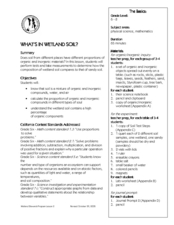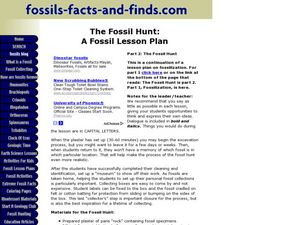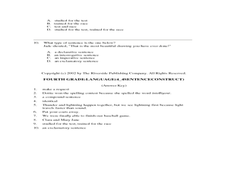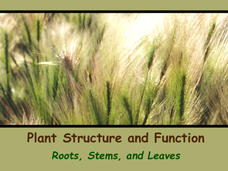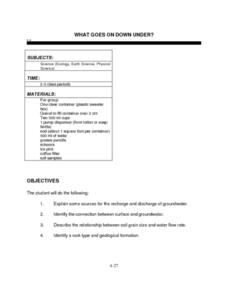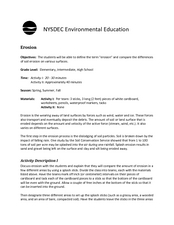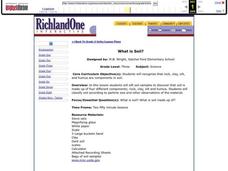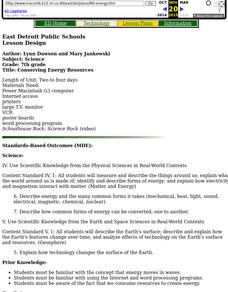Curated OER
The Oregon Trail
Students use maps and diagrams to examine the Oregon Trail. In groups, they create their own poster of the trail showing the different types of artifacts found along the way. To end the lesson, they identify the sources of water and...
Curated OER
What's in Wetland Soil?
Students examine the organic and inorganic components of soil. For this environmental science lesson, students identify the factors that influence soil formation. They collect soil samples, conduct tests, and analyze the results.
Curated OER
Summing Up the Disaster
Young scholars are introduced to news writing being a concise, factual, and informative type of writing. They assess that publishing an article in a newspaper style utilizes a word processing program. Each student researches the Titanic...
Curated OER
Tourism in Northern Ireland
In this tourism instructional activity, students label pictures of tourist destinations with the name of the country they are located in, write sentences about pictures showing damage caused by tourists, identify locations on a map, and...
Curated OER
The Fossil Hunt
Learners recall prior knowledge of the process of fossilization. For this fossils lesson, students first create and at a later date, recover fossils. Learners understand the painstaking process of recovering a fossil. Students recover...
Curated OER
Sentence Stucture
In this analyzing sentences worksheet, 4th graders identify purpose, combining, types, and grammar. Students answer 10 questions.
Curated OER
Mixtures of Matter
Students experiment with mixtures of matter. In this matter instructional activity, students investigate which liquids form a solution when mixed together and which do not. Students also identify which solids can be separated from matter.
Curated OER
A Special Relationship: Connecticut and Its Settlers
Students study both geological and geographical features of Connecticut and the New Haven area. They focus on map works and rock formation.
Curated OER
Sedimentary Structures- An Adventure in Painting and Collage
Students identify and interpret concepts about how the Earth was formed and convey some of these ideas in a painting.
Students experiment with different types of paints and paint applicators to achieve a variety of visual textures....
It's About Time
Chemistry and Physical Changes
Engage the class like never before as pupils learn to differentiate between multiple physical and chemical changes by conducting a list of small experiments, most often with household materials. They make observations and discuss the...
Teach Engineering
Body Full of Crystals
Your body has lots of crystals, just not any gemstones. The first installment of a three-part unit provides a PowerPoint presentation on crystallization occurring in the human body and about crystallization in general. The resource gives...
University of Virginia
The Songs in Uncle Tom's Cabin
Experience Harriet Beecher Stowe's Uncle Tom's Cabin in an innovative, musical way. A list of audio links leads class members to spirituals from the novel, such as "Die in the Field," "The Wings in the Morning," and "Blow Ye the Trumpet."
Biology Junction
Plant Structure and Function: Roots, Stems, and Leaves
Scientists found fossils of plants more than 420 million years old—but plants existed for up to 100 million years prior to these fossils. Learn about the importance of plants to the entire planet. Viewing a presentation helps scholars...
Curated OER
Weathering Landforms
Fifth graders brainstorm a list of ways the Earth's surface can change. As a class, they are introduced to the concepts of erosion and weathering and discover how wind and water cause changes to the surface of the Earth. To end the...
Curated OER
Edible Coal Mining
Learners explore the concept of bituminous coal and the role it plays within our world. In this economic and earth science lesson, middle schoolers discover and model the extraction methods with hands-on activities. Learners also...
Curated OER
What Goes On Down Under?
Young scholars explore the sources for recharge and discharge of groundwater. They research the connection between surface water and groundwater. Students construct a model of an aquifer and explore recharge and discharge of the aquifer.
Curated OER
Skeletal System
Seventh graders explore the functions of the skeletal system. They collaborate in small groups to determine the function of the skeletal system, the types of joints and movement, bone strength and growth, and bone injuries including...
Curated OER
Forces Inside the Earth
In this faults worksheet, students identify the three types of faults and the characteristics that define a normal fault, reverse fault, and a strike-slip fault. This worksheet has 3 fill in the blank and 3 short answer questions.
Curated OER
Erosion
Pupils study various types of erosion. The purpose of these activities is to increase students awareness to the point where they can make intelligent decisions on proper land use.
Curated OER
COMPARE SOILS BY GROWING PLANTS
The student will identify the difference in the rate of plant growth in three soils that vary in organic matter.1. Obtain three to four flowerpots, different types of soil, a record chart, three to five beans for each pot, and water....
Curated OER
Energy Resources Scavenger Hunt
In this environment worksheet, students complete each of the statements with its correct energy resource. They identify and name various types of plants and rocks. Students also identify and explain how fertilizer works and how it can be...
Curated OER
Gravity
In this gravity worksheet, 8th graders complete 4 different questions related to defining gravity. First, they identify the various types of mass movement that is described in each. Then, students explain what each of the 4 types of...
Curated OER
What is Soil?
Third graders examine what makes soil by creating a Venn Diagram. In this Earth environment lesson, 3rd graders identify the different components that soil is made from. Students bring soil from their homes to examine and create a Venn...
Curated OER
Conserving Energy Resources
Seventh graders research on energy conversion. After they have researched several types of energy resources, teams of two to four create posters which depict how these resources can be conserved.



